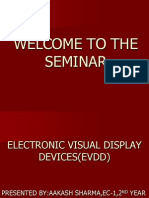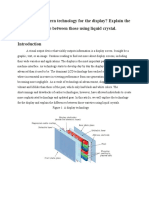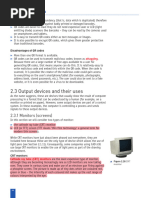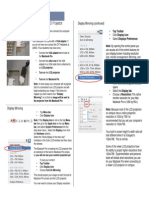Cs 1
Uploaded by
shawn ʕ•ᴥ•ʔCs 1
Uploaded by
shawn ʕ•ᴥ•ʔ3.
2 Input and output devices
» when the white light hits these mirrors, the reflected light has wavelengths
corresponding to red, green and blue light components
» these three different coloured light components pass through three LCD
screens (each screen is composed of thousands of tiny pixels which can either
block light or let it through; this produces a monochromatic image)...
» ... consequently, three different versions of the same image are now produced
– one is the whole image in different shades of red, one is the whole image
in different shades of green and one is the whole image in different shades of
blue
» these images are then re-combined using a special prism to produce a full
colour image
» finally, the image passes through the projector lens onto a screen.
light
mirror source
red
lens
component
LCD screens
image
dichromic
projected
mirrors
on to screen prism
green
component
blue
component
mirror
▲ Figure 3.38 LCD projector
Advantages and disadvantages of the two types of projector
▼ Table 3.5 Advantages and disadvantages of DLP and LCD projectors
Advantages Disadvantages
higher contrast ratios image tends to suffer from ‘shadows’ when
higher reliability/longevity showing a moving image
quieter running than LCD projector DLP do not have grey components in the image
Digital light uses a single DMD chip, which mean no issues
projector (DLP) lining up the images the colour definition is frequently not as good as
LCD projectors because the colour saturation is
smaller and lighter than LCD projector
not as good (colour saturation is the intensity of a
they are better suited to dusty or smoky colour)
atmospheres than LCD projectors
although improving, the contrast ratios are not as
give a sharper image than DLP projectors
good as DLPs
LCD projectors have a limited life (that is, the
have better colour saturation than DLP projectors
LCD projector longevity is not as good as DLPs)
more efficient in their use of energy than DLP since LCD panels are organic in nature, they tend
technology – consequently they generate less to degrade with time (screens turn yellow and the
heat colours are subsequently degraded over time)
103
318281_C03_CAM_IGCSE CO_SCI_075_146.indd 103 18/02/21 3:51 PM
You might also like
- The Great Technology War: LCD vs. DLP: Highly Recommended Home Theater Projectors For More On LCOS Click HereNo ratings yetThe Great Technology War: LCD vs. DLP: Highly Recommended Home Theater Projectors For More On LCOS Click Here5 pages
- Seminar Report ON Projector: Panipat Institute of Engeerning & TecnologyNo ratings yetSeminar Report ON Projector: Panipat Institute of Engeerning & Tecnology19 pages
- Ackowledgemet: Miss. Elsa Baby and My Seminar Coordinator Mrs. Leena ThomasNo ratings yetAckowledgemet: Miss. Elsa Baby and My Seminar Coordinator Mrs. Leena Thomas33 pages
- Wireless Pink Robo By.... Saranya BhavsinghNo ratings yetWireless Pink Robo By.... Saranya Bhavsingh33 pages
- Differentiate Liquid Crystal Display (LCD) From Digital Light Processing. Give Their Advantages and DisadvantagesNo ratings yetDifferentiate Liquid Crystal Display (LCD) From Digital Light Processing. Give Their Advantages and Disadvantages3 pages
- Projectors 150119151058 Conversion Gate02 PDFNo ratings yetProjectors 150119151058 Conversion Gate02 PDF13 pages
- Beige Pink Cute Creative Portfolio Presentation_20250323_150921_0000No ratings yetBeige Pink Cute Creative Portfolio Presentation_20250323_150921_00006 pages
- Tech Support Training Technology OverviewNo ratings yetTech Support Training Technology Overview87 pages
- What Is DLP Technology?: Digital Light ProcessingNo ratings yetWhat Is DLP Technology?: Digital Light Processing4 pages
- Difference Between CRT and LCD: Flat Screen (CRT) Monitor100% (1)Difference Between CRT and LCD: Flat Screen (CRT) Monitor3 pages
- Islam Aur Jadid Bankari - Islam and Present Banking System100% (1)Islam Aur Jadid Bankari - Islam and Present Banking System113 pages
- Liquid Crystal Display: By: Neelanshu Nikita Pallabi NileshNo ratings yetLiquid Crystal Display: By: Neelanshu Nikita Pallabi Nilesh27 pages
- Projector: Submited by Mohamed Basil UEC17CS026No ratings yetProjector: Submited by Mohamed Basil UEC17CS02610 pages
- Lectures On Virtual Environment Development L5No ratings yetLectures On Virtual Environment Development L570 pages
- See It Now: A Primer On LCD, DLP, Lcos, and Plasma TechnologiesNo ratings yetSee It Now: A Primer On LCD, DLP, Lcos, and Plasma Technologies47 pages
- Digital Light Processing (DLP) Revolution in VisionNo ratings yetDigital Light Processing (DLP) Revolution in Vision4 pages
- Distance Fog: Exploring the Visual Frontier: Insights into Computer Vision's Distance FogFrom EverandDistance Fog: Exploring the Visual Frontier: Insights into Computer Vision's Distance FogNo ratings yet
- Global Illumination: Advancing Vision: Insights into Global IlluminationFrom EverandGlobal Illumination: Advancing Vision: Insights into Global IlluminationNo ratings yet
- Connecting Your Macbook Pro To The LCD Projector: Display Mirroring (Continued)No ratings yetConnecting Your Macbook Pro To The LCD Projector: Display Mirroring (Continued)1 page
- Optical System Design in Projection DisplayNo ratings yetOptical System Design in Projection Display25 pages
- TheGateOfJANUA LINGUARUM RESARATA THE GATE OF LANGUAGE UNLOCKED - . - and Set Ajar - A Language Game - by Tjebbe Van TijenLanguage1999Tjebbe"100% (1)TheGateOfJANUA LINGUARUM RESARATA THE GATE OF LANGUAGE UNLOCKED - . - and Set Ajar - A Language Game - by Tjebbe Van TijenLanguage1999Tjebbe"6 pages
- Name of Equipment No. of Units Dept./Personnel-in-ChargeNo ratings yetName of Equipment No. of Units Dept./Personnel-in-Charge2 pages
- Stereobright™: Innovative Technology From Advanced Visual Solutions (Patent Pending)No ratings yetStereobright™: Innovative Technology From Advanced Visual Solutions (Patent Pending)15 pages
- Device Type: LCD Projector: Partner: Epson Model: EB-X11No ratings yetDevice Type: LCD Projector: Partner: Epson Model: EB-X113 pages
- Basics of Information and Communication Technology Munawar Siddique CC430340No ratings yetBasics of Information and Communication Technology Munawar Siddique CC43034017 pages
- Answer The Following Questions.: Activity 12: Maximizing LCD Projector and Chalkboard in The ClassroomNo ratings yetAnswer The Following Questions.: Activity 12: Maximizing LCD Projector and Chalkboard in The Classroom2 pages
- Name: - Grade and Section: - Teacher: - DateNo ratings yetName: - Grade and Section: - Teacher: - Date5 pages



















































































